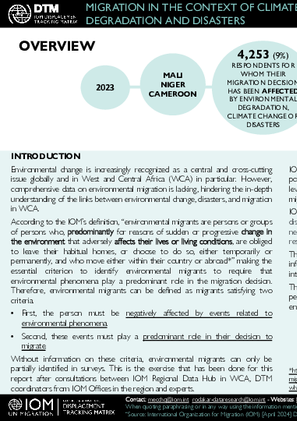-
Countries
-
Data and Analysis
-
Special Focus
-
Crisis Responses
Flow Monitoring
Domain host
migration.iom.int

Contact
iomguatemala@iom.int
Language
English
Location
Guatemala
Period Covered
Feb 01 2024
Feb 29 2024
Activity
- Flow Monitoring
In Februrary 2024, 22,402 movements were observed in Guatemala (18% children) and 400 individuals were surveyed.1 The number of observed movements decreased by 6 per cent from January 2024 (23,690) due to operational constraints in data collection. More than half of surveyed individuals originated from the Bolivarian Republic of Venezuela (63%). The main intended destination was the United States of America (90%).
Since 2022, migratory flows through the Latin America and Caribbean region have increased significantly, with record levels of persons crossing the perilous jungle of the Darién National Park from Colombia into Panama. The in-transit flows tracked in Guatemala have mirrored these regional migration trends.

Contact
iomguatemala@iom.int
Language
English
Location
Guatemala
Period Covered
Feb 01 2024
Feb 29 2024
Activity
- Flow Monitoring
En febrero de 2024 se observaron 22,402 movimientos en Guatemala (18% niños, niñas y adolescentes) y 400 personas fueron encuestadas.1 El número de movimientos observados disminuyó un 6 por ciento desde enero de 2024 (23,690) debido a limitaciones operativas en la recolección de datos. Más de la mitad de las personas encuestadas procedía de la República Bolivariana de Venezuela (63%). El principal destino previsto fue los Estados Unidos de América (90%).
Desde 2022, los flujos de migrantes en tránsito se incrementaron significativamente en la región de América Latina y el Caribe, observando cantidades nunca antes registradas de personas que cruzan la peligrosa selva del Parque Nacional del Darién desde Colombia hacia Panamá. Los flujos en tránsito observados en Guatemala han reflejado dichas tendencias migratorias regionales
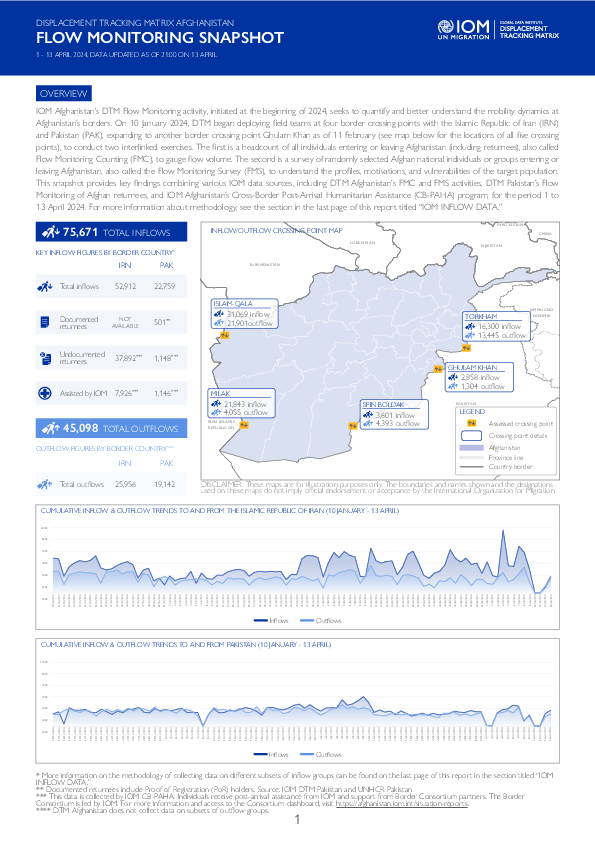
Contact
DTMAfghanistan@iom.int
Language
English
Location
Afghanistan
Period Covered
Apr 01 2024
Apr 13 2024
Activity
- Survey
- Flow Monitoring Survey
- Flow Monitoring
IOM Afghanistan's DTM Flow Monitoring activity, initiated at the beginning of 2024, seeks to quantify and better understand the mobility dynamics at Afghanistan’s borders. On 10 January 2024, DTM began deploying field teams at four border crossing points with the Islamic Republic of Iran (IRN) and Pakistan (PAK), expanding to another border crossing point Ghulam Khan as of 11 February (see map below for the locations of all five crossing points), to conduct two interlinked exercises. The first is a headcount of all individuals entering or leaving Afghanistan (including returnees), also called Flow Monitoring Counting (FMC), to gauge flow volume. The second is a survey of randomly selected Afghan national individuals or groups entering or leaving Afghanistan, also called the Flow Monitoring Survey (FMS), to understand the profiles, motivations, and vulnerabilities of the target population. This snapshot provides key findings combining various IOM data sources, including DTM Afghanistan’s FMC and FMS activities, DTM Pakistan’s Flow Monitoring of Afghan returnees, and IOM Afghanistan’s Cross-Border Post-Arrival Humanitarian Assistance (CB-PAHA) program, for the period 1 to 13 April 2024. For more information about methodology, see the section in the last page of this report titled “IOM INFLOW DATA.”
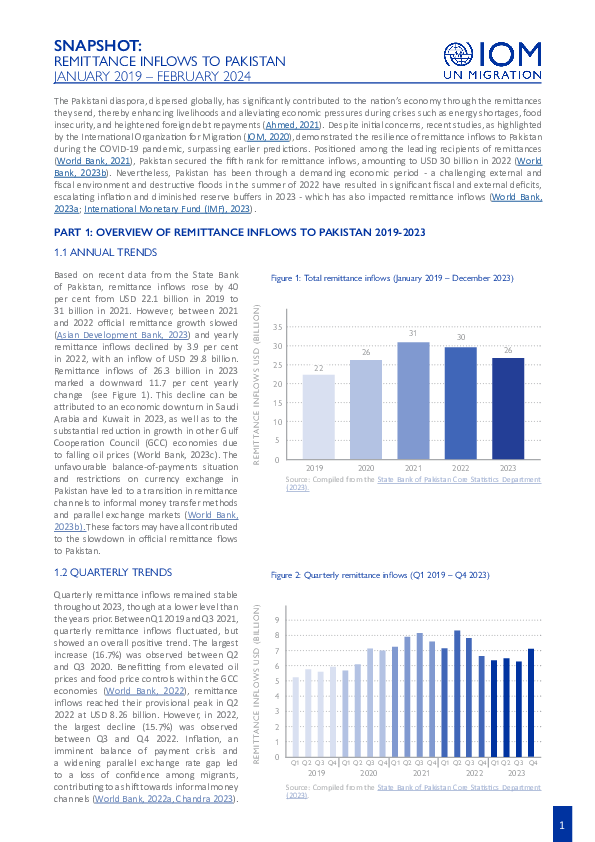
Contact
rdhroapsupport@iom.int, dtmremapsupport@iom.int
Language
English
Location
Pakistan
Period Covered
Jan 01 2019
Feb 29 2024
Activity
- Other
This report on remittance inflows to Pakistan from 2019 to 2024 details the fluctuating trends in money sent home by the Pakistani diaspora. The report highlights the economic impact of these financial transfers. Initially, remittances grew significantly, reaching USD 31 billion in 2021, but this was followed by a decline, with 2023 seeing a drop to USD 26.3 billion, largely due to economic issues in the Gulf Cooperation Council countries and restrictive financial policies in Pakistan. Despite these challenges, remittance inflows remained a critical source of foreign exchange and economic stability, particularly during crises such as the COVID-19 pandemic and the 2022 floods.
Environmental change is increasingly recognized as a central and cross-cutting issue globally and in West and Central Africa (WCA) in particular. However, comprehensive data on environmental migration is lacking, hindering the in-depth understanding of the links between environmental change, disasters, and migration in WCA.
According to the IOM’s definition, “environmental migrants are persons or groups of persons who, predominantly for reasons of sudden or progressive change in the environment that adversely affects their lives or living conditions, are obliged to leave their habitual homes, or choose to do so, either temporarily or permanently, and who move either within their country or abroad” making the essential criterion to identify environmental migrants to require that environmental phenomena play a predominant role in the migration decision.
This first dashboard aims at providing detailed information and evidence on people on the move in the context of disasters, climate change, and environmental degradation.
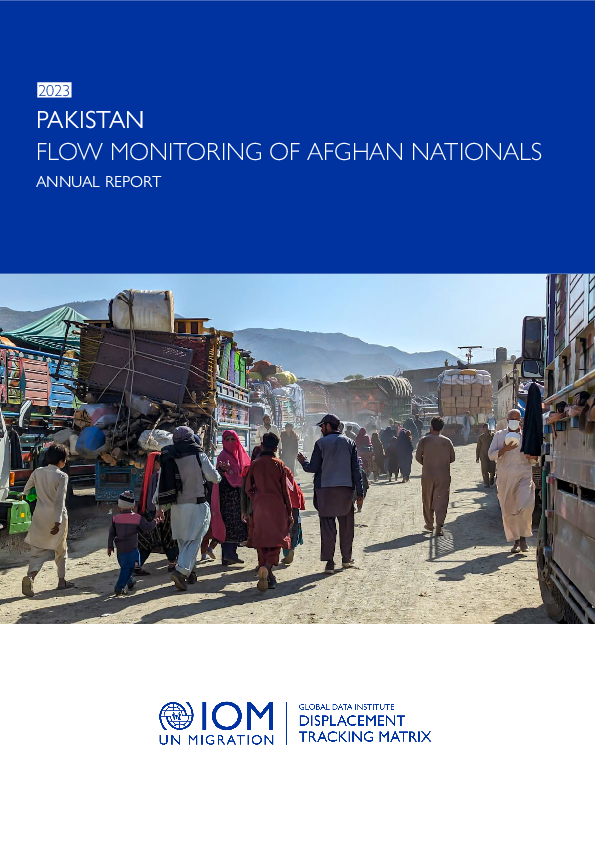
Contact
DTMPakistan@iom.int
Language
English
Location
Pakistan
Period Covered
Jan 01 2023
Dec 31 2023
Activity
- Flow Monitoring
This report presents a comprehensive analysis of the movement trends involving Afghan returnees from Pakistan. The assessment was conducted from January to December 2023 and employs the Displacement Tracking Matrix (DTM) methodology across several Border Crossing Points (BCPs) to analyse movement trends of Afghan returnees from Pakistan. IOM collected data from 23,860 household heads, representing 558,212 Afghan nationals.
The report highlights the significant increase in the number of returnees following the enactment of Pakistan's "Illegal Foreigners’ Repatriation Plan (IFRP)," which led to a marked spike in movements during the fourth quarter of 2023. It also details the demographics and vulnerabilities of the returnees, showing that a substantial number are undocumented or hold invalid documentation.
Additionally, the report examines the socio-economic impacts on the returnees, such as changes in their source of income and types of residence before and after their return. It further notes the challenges returnees anticipate in Afghanistan, including finding employment, securing shelter, and reintegrating into society.
Contact
iomyemendtm@iom.int
Location
Yemen
Activity
- Flow Monitoring
- Mobility Tracking
- Baseline Assessment
Period Covered
Mar 01 2024 -Mar 31 2024
In March 2024, IOM Yemen DTM recorded 1,930 migrants entering Yemen, an increase of 11 per cent compared to last month (1,744). Shabwah typically serves as an entry point for migrants departing from Somalia and rarely sees migrants departing from Djibouti due to the considerable distance between Djibouti and Shabwah. Thus, Shabwah was the arrival destination for 93 per cent of migrants departed from Bari, Somalia (1,800). The overall number of migrants entering through Shabwah has increased by three per cent in March (1,800) compared to February 2024 (1,744). Moreover, the team in Abyan governorate recorded new migrants landing in Ahwar district - Hesn Balead FMP. The number of migrants arriving through Abyan coast reached to 130 (all departed from Somalia).
According to DTM, conflict-induced movements constituted 57 per cent of all incoming movements in March 2024. These movements were exclusively observed in Shabwah, originating from Bari, Somalia (21% children, 23% women, and 56% men).
DTM observed an increase in Yemeni returnees by 36 per cent in March (4,226) compared to February (3,116). Furthermore, in March 2024, a total of 411 migrants ( 385 Ethiopian, 25 Yemeni, and one Somali) were deported from Oman back to Hawf district of Al Maharah governorate, Yemen.
The deteriorating humanitarian crisis in Yemen has forced many migrants to make the difficult decision to return to their home countries in the Horn of Africa. Others are reported to have been deported by authorities. DTM recorded that in March 2024, a total of 1,174 migrants either opted to take the risky journey back or were deported by boat from Yemen. This group consisted of 91 per cent men, seven per cent women, and two per cent children.
Additionally, the Djibouti DTM team documented that during the same period, a total of 1,177 migrants (92 per cent men, four per cent women, and four per cent children) embarked on a dangerous journey back home by boat from Yemen. These numbers highlight the significant challenges faced by migrants in Yemen and the desperate situations that have driven them to undertake perilous voyages across the sea.
Population Groups
Survey Methodology
Unit of Analysis Or Observation
Type of Survey or Assessment
Keywords
Geographical Scope
Administrative boundaries with available data
The current dataset covers the following administrative boundaries
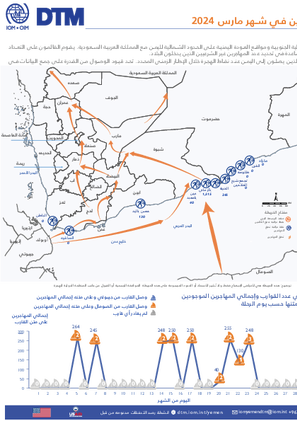
Contact
DTM Yemen, DTMYemen@iom.int
Language
English
Location
Yemen
Period Covered
Mar 01 2024
Mar 31 2024
Activity
- Flow Monitoring
- Mobility Tracking
- Baseline Assessment
يقوم سجل مراقبة التدفق التابع لمصفوفة تتبع النزوح (FMR) التابع للمنظمة الدولية للهجرة في اليمن بمراقبة وصول المهاجرين على الحدود الساحلية الجنوبية ومواقع العودة اليمنية على الحدود الشمالية لليمن مع المملكة العربية السعودية. يقوم القائمون على التعداد الموجودون في نقاط مراقبة التدفق بتسجيل المهاجرين الوافدين والمواطنين اليمنيين العائدين لتحديد أنماط الهجرة المختلفة، ولتقديم تقديرات كمية للمساعدة في تحديد عدد المهاجرين غير الشرعيين الذين يدخلون البلاد.
لا تمثل الهجرة القسرية جميع التدفقات في اليمن وينبغي فهمها على أنها مؤشر فقط لاتجاهات الهجرة للعدد الإجمالي غير المعروف للمهاجرين الذين يصلون إلى اليمن عند نقاط الهجرة خلال الإطار الزمني المحدد. تحد قيود الوصول من القدرة على جمع البيانات في بعض نقاط وصول المهاجرين.
وفي محاولة للحد من تدفق المهاجرين الداخلين إلى اليمن، والذي يعبر البلاد بشكل أساسي متجهاً نحو المملكة العربية السعودية ودول الخليج الأخرى، بدأت حملة عسكرية مشتركة في أغسطس 2023. ركزت هذه الحملة على ساحل محافظة لحج، نقطة دخول مهمة لعدد كبير من المهاجرين (بحد أقصى 15,714 مهاجرًا في مارس 2023). احتجز الجيش المهربين وطارد قواربهم، مما أدى إلى انخفاض مطرد في تدفق المهاجرين عبر هذا الساحل حتى توقف تماما خلال الأشهر الخمسة الماضية، مع استثناء واحد في منتصف ديسمبر/كانون الأول 2023 عندما تمكن قارب يحمل 110 مهاجرين من الوصول إلى الساحل. أرض.
في مارس 2024، سجلت مصفوفة تتبع النزوح التابعة للمنظمة الدولية للهجرة في اليمن دخول 1,930 مهاجرًا إلى اليمن، بزيادة قدرها 11 بالمائة مقارنة بالشهر الماضي (1,744). تعتبر شبوة عادة نقطة دخول للمهاجرين من الصومال ونادرا ما تشهد مغادرة المهاجرين من جيبوتي بسبب المسافة الكبيرة بين جيبوتي وشبوة. وهكذا، كانت شبوة وجهة وصول 93 في المائة من المهاجرين المغادرين من باري، الصومال (1,800). ارتفع العدد الإجمالي للمهاجرين الذين يدخلون عبر شبوة بنسبة ثلاثة في المائة في مارس (1,800) مقارنة بشهر فبراير 2024 (1,744). علاوة على ذلك، سجل الفريق في محافظة أبين هبوط مهاجرين جدد في مديرية أحور - مركز حصن بلعيد. ووصل عدد المهاجرين الذين وصلوا عبر ساحل أبين إلى 130 مهاجراً (جميعهم غادروا الصومال).
وفقًا لمصفوفة تتبع النزوح، شكلت الحركات الناجمة عن النزاع 57% من جميع الحركات الواردة في مارس 2024. وقد لوحظت هذه الحركات حصريًا في شبوة، مصدرها باري بالصومال (21% أطفال، 23% نساء، 56% رجال).
ولاحظت مصفوفة تتبع النزوح زيادة في عدد العائدين اليمنيين بنسبة 36 بالمائة في مارس (4,226) مقارنة بشهر فبراير (3,116). علاوة على ذلك، في مارس 2024، تم ترحيل ما مجموعه 411 مهاجرًا (385 إثيوبيًا و25 يمنيًا وصوماليًا واحدًا) من عمان إلى مديريتي شحن وحوف في محافظة المهرة باليمن.
أجبرت الأزمة الإنسانية المتدهورة في اليمن العديد من المهاجرين على اتخاذ القرار الصعب بالعودة إلى بلدانهم الأصلية في القرن الأفريقي. وبحسب ما ورد قامت السلطات بترحيل آخرين. سجلت مصفوفة تتبع النزوح أنه في مارس 2024، اختار ما مجموعه 1,174 مهاجرًا إما القيام برحلة العودة المحفوفة بالمخاطر أو تم ترحيلهم بالقوارب من اليمن. وتتكون هذه المجموعة من 91 في المائة رجال، و7 في المائة نساء، و2 في المائة أطفال.
بالإضافة إلى ذلك، وثّق فريق مصفوفة تتبع النزوح في جيبوتي أنه خلال الفترة نفسها، انطلق ما مجموعه 1,177 مهاجرًا (92% رجال، و4% نساء، و4% أطفال) في رحلة خطيرة للعودة إلى وطنهم بالقوارب من اليمن. تسلط هذه الأرقام الضوء على التحديات الكبيرة التي يواجهها المهاجرون في اليمن والأوضاع اليائسة التي دفعتهم إلى القيام برحلات محفوفة بالمخاطر عبر البحر.
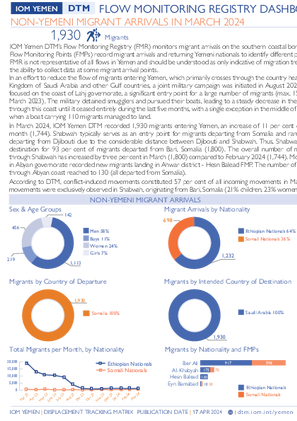
Contact
DTM Yemen, DTMYemen@iom.int
Language
English
Location
Yemen
Period Covered
Mar 01 2024
Mar 31 2024
Activity
- Flow Monitoring
- Mobility Tracking
- Baseline Assessment
IOM Yemen DTM’s Flow Monitoring Registry (FMR) monitors migrant arrivals on the southern coastal border and Yemeni return locations on Yemen's northern border with the Kingdom of Saudi Arabia (KSA). Enumerators placed at Flow Monitoring Points (FMPs) record migrant arrivals and returning Yemeni nationals to identify different patterns of migration, and to provide quantitative estimates to help define the population of irregular migrants entering the country.
FMR is not representative of all flows in Yemen and should be understood as only indicative of migration trends of the unknown total number of migrants arriving in Yemen at FMPs during the time frame indicated. Access constraints limit the ability to collect data at some migrant arrival points.
In an effort to reduce the flow of migrants entering Yemen, which primarily crosses through the country heading towards the Kingdom of Saudi Arabia and other Gulf countries, a joint military campaign was initiated in August 2023. This campaign focused on the coast of Lahj governorate, a significant entry point for a large number of migrants (max. 15,714 migrants in March 2023). The military detained smugglers and pursued their boats, leading to a steady decrease in the flow of migrants through this coast until it ceased entirely during the last five months, with a single exception in the middle of December 2023 when a boat carrying 110 migrants managed to land.
In March 2024, IOM Yemen DTM recorded 1,930 migrants entering Yemen, an increase of 11 per cent compared to last month (1,744). Shabwah typically serves as an entry point for migrants departing from Somalia and rarely sees migrants departing from Djibouti due to the considerable distance between Djibouti and Shabwah. Thus, Shabwah was the arrival destination for 93 per cent of migrants departed from Bari, Somalia (1,800). The overall number of migrants entering through Shabwah has increased by three per cent in March (1,800) compared to February 2024 (1,744). Moreover, the team in Abyan governorate recorded new migrants landing in Ahwar district - Hesn Balead FMP. The number of migrants arriving through Abyan coast reached to 130 (all departed from Somalia).
According to DTM, conflict-induced movements constituted 57 per cent of all incoming movements in March 2024. These movements were exclusively observed in Shabwah, originating from Bari, Somalia (21% children, 23% women, and 56% men).
DTM observed an increase in Yemeni returnees by 36 per cent in March (4,226) compared to February (3,116). Furthermore, in March 2024, a total of 411 migrants ( 385 Ethiopian, 25 Yemeni, and one Somali) were deported from Oman back to Hawf district of Al Maharah governorate, Yemen.
The deteriorating humanitarian crisis in Yemen has forced many migrants to make the difficult decision to return to their home countries in the Horn of Africa. Others are reported to have been deported by authorities. DTM recorded that in March 2024, a total of 1,174 migrants either opted to take the risky journey back or were deported by boat from Yemen. This group consisted of 91 per cent men, seven per cent women, and two per cent children.
Additionally, the Djibouti DTM team documented that during the same period, a total of 1,177 migrants (92 per cent men, four per cent women, and four per cent children) embarked on a dangerous journey back home by boat from Yemen. These numbers highlight the significant challenges faced by migrants in Yemen and the desperate situations that have driven them to undertake perilous voyages across the sea
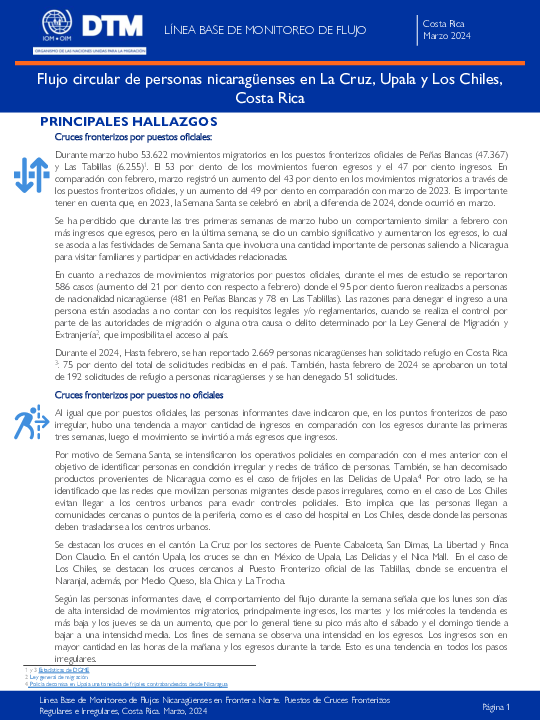
Contact
DTMCostaRica@iom.int
Language
Spanish
Location
Costa Rica
Period Covered
Mar 01 2024
Mar 31 2024
Activity
- Flow Monitoring
- Baseline Assessment
La Organización Internacional para las Migraciones (OIM), como agencia de las Naciones Unidas en materia de migración en Costa Rica, implementó, desde 2021, dos rondas de la Matriz de Seguimiento al Desplazamiento (DTM por sus siglas en inglés) como parte de su estrategia de monitoreo del flujo migratorio circular de personas de nacionalidad nicaragüense, en puntos fronterizos no oficiales, en distintos cantones del norte del país. A partir de este ejercicio en tres puntos de ingreso no oficial de la frontera con Nicaragua, se contabilizaron 60 697 movimientos migratorios, de los cuales el 59 por ciento fueron egresos y 41 por ciento ingresos.
Siendo parte fundamental de la misión de OIM brindar asesoría clave sobre políticas y prácticas migratorias, se vuelve necesario actualizar los datos de este flujo migratorio circular de nicaragüenses que cruzan tanto de forma regular como irregular la frontera norte de Costa Rica.
Según los registros de la DGME de ingresos y egresos regulares por puestos fronterizos oficiales en Los Chiles y Peñas Blancas, en 2022 hubo 394.730 movimientos migratorios regulares (50 % ingresos y 50 % egresos) mientras que durante el 2023, en total se registraron 526.271 movimientos migratorios (50 % ingresos y 50 % egresos), lo cual representó un aumento de 33 por ciento con respecto a 2022. Durante marzo de 2024, se realizaron un total de 53.622 movimientos migratorios siendo el 53 por ciento egresos y el 47 por ciento egresos.
Pagination
- Previous page
- Page 16
- Next page
